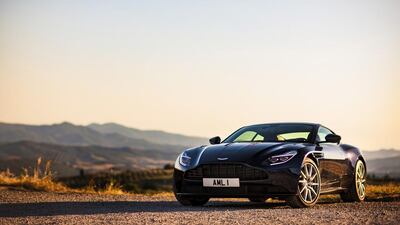After a century that was as often characterised by toil and trouble as its deeply evocative cars, Aston Martin had found itself at something of a crossroads. A dated model range meant that seeing a contemporary Aston had, for too long, become a Groundhog Day-esque experience. The flagship DB9 was more than a decade old; pretty much the rest of its output was overdue an overhaul – the formula was teetering dangerously towards formulaic.
A good job, then, that the DB11 blows all that has gone before it clear out of the water, suggesting that if this first offering of Aston’s self-proclaimed “second-century plan” is anything to go by, then the next 100 years could be rather rewarding for lovers of beefy British grand tourers.
Its visual triumph is the most encouraging factor. From the front, it's still unmistakably an Aston, with signature shapes remaining present in the lights and grille, yet more streamlined and sportier. Any initial disappointment that the nose doesn't grab more influence from stunning but sadly non-production James Bond car the DB10 is countered by its shapely, angular rear, which also contains echoes of the Jaguar F-Type's hind quarters. Here, the design language has used the Spectre special as a launch pad rather than a too-adventurous-to-be-unobtainable ideal, continuing a distinctive evolution that seemed stalled for too many years. It's the perfect melding of past and present. The spectre of the DB10 is again visible in the muscular rear arches, which flare wildly from the rear of the doors.
Megabucks projects such as the Vulcan and Valkyrie aside, it’s probably the first time that Aston has crafted a solid-gold head-turner to rival the supercar ranks, as opposed to a more-stately sportster for connoisseurs. The effect is literally jaw-dropping in the case of one teenaged boy who I pass during my test drive – his mouth cartoonishly falls opens, agog, when he spies the DB11. A DB9 or a Vanquish would glean second glances, sure, particularly when it comes to some of the latter’s special-edition guises, but such an extreme reaction? Not likely. It’s particularly easy on the eye in the Mariana blue of my Launch Edition test car.
Aston’s commitment to hand-built production processes can present a certain charming roughness, which depending on your viewpoint, could either make or break the whole proposition. I have to push scraps of insulation back inside the trim on the driver’s door sill, right next to the plate informing you of the laborious manual craftsmanship that goes into each DB11. The door handles, which sit flush in the door panel, feel a touch flimsy when you pop them out, like they might snap off in your hand given a strong yank. But the dash is the only real let-down – the classiness of its leather trim is juxtaposed with cheap-looking shiny plastic across the infotainment and air-conditioning settings, as well as the unwieldy mouse, and many of the controls have next to no purchase or feel to them. Indeed, the design familiarity of the gear-select and starter buttons – there’s no gear stick of any description here – might make you suspect that Aston ripped out the core of a DB9 dash and repurposed it (although pop-up Bang & Olufsen speakers and the electrically operated cover of the central console cubbyhole are rather more forward-thinking).
There can be no such accusations when you open the bonnet or the throttle, however. The spanking new 5.2L twin-turbo V12 is down in capacity from its predecessor’s 6.0L unit, while purists might be grimacing at the prospect of a turbocharged Aston, but fear not: its 600bhp, 700Nm of torque, 0-to-100kph time of 3.9 seconds and top speed of 321kph are all enviable improvements on the DB9.
The raft of air intakes feed some clever aerodynamics, not least the “virtual” AeroBlade spoiler created by the ducts at the base of the C-pillars, and you will be grateful for the extra aid once Sport+ mode is engaged, with the V12 firing angrily through to vocal dual exhausts. All of which translates into an on-road urgency that begs you to abandon grand-tourer pretensions and be utterly unpleasant to the accelerator, with finely poised balance that will ensure you don’t end up depositing the best part of two tonnes into the nearest central reservation. Admittedly, it isn’t nimble in a supercar sense, but it’s a different sensation of weight compared to a competitor such as the Bentley Continental GT, albeit with brakes that could benefit from a little more initial bite. And when you do settle into a touring trip, the DB11’s increased interior dimensions won’t leave you clambering out after a long journey feeling like you have just suffered a going-over from a class of trainee chiropractic students. Two adults below bricklayer dimensions can just about squeeze into the bucket-tastic back seats, should the need arise, too, with the introduction of Isofix attachments for child seats.
It’s hard not to be envious of such youngsters, because the DB11 has the chops for all moods. By all accounts, it seems that right now they’re selling as fast as Aston can make them. Here’s hoping that such demand can make Aston Martin’s second century somewhat less financially trepidatious than its first, because the DB11 is a car worthy of building a company around.
aworkman@thenational.ae
Follow us @LifeNationalUAE
Follow us on Facebook for discussions, entertainment, reviews, wellness and news.

